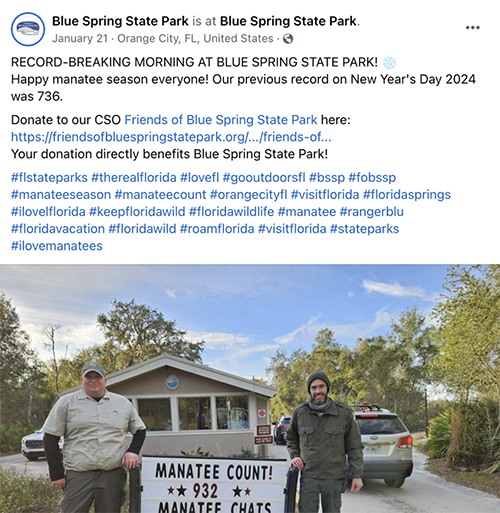
In the crystal clear turquoise waters of Blue Spring State Park in Florida, an extraordinary sight unfolds – not rocks or fish, but a multitude of majestic manatees gracefully gliding through the warm, shallow lagoons.
This annual phenomenon has captivated rangers and wildlife biologists, who witness the gentle giants seeking refuge from winter’s chill in the sanctuary of the park’s inviting waters.
For decades, Blue Spring State Park has served as a haven for manatees, offering respite against sudden cold snaps that threaten their survival. It has become a traditional for park rangers to conduct a “manatee count” each winter, providing invaluable insights into the population dynamics of these beloved marine mammals.
However, this year’s tally surpassed all expectations, reaching unprecedented levels of manatee aggregation.
On January 21st, a momentous day etched in the park’s history, an astounding 932 manatees were recorded throughout the lagoons – an astonishing 200 more than the previous record for the largest “aggregation.”
Despite their robust appearance reminiscent of seals and walruses, manatees possess only a thin layer of fat, rendering them vulnerable to prolonged exposure to water temperatures below 68°F, as explained by the Smithsonian’s Christian Thorsberg.

Consequently, as winter descends and water temperatures plummet, these endearing “sea cows” embark on a quest for warmer inland waters.
The remarkable influx of manatees to Blue Springs is hailed as a heartening sign by conservations like Cora Berchem, a manatee research associate at the nonprofit Save the Manatee Club.
In an interview with NPR, Berchem expressed optimism, interpreting the mass migration as evidence of the manatees’ profound understanding of their environment. This heightened environmental awareness augurs well for the species, enhancing their chances of survival across generations in the face of similar climatic challenges.
The resurgence of manatee populations across Florida is a cause for celebration and reflection. From an estimated 1,000 individuals half a century ago, the current population ranges between 7,000 and 11,000, marking an incredible recovery.
The park’s website shares that they began their research on the manatees sometime in the 1970s, and their number went from 36 to more than 700 in 2023.
Despite surviving many threats, like habitat loss, algae blooms, pollution and watercraft collisions, these gentle creatures have been able to use the Blue Spring State Park as a sanctuary for survival. The website also explains that the park serves as an optimal location for releasing rehabilitated manatees back to their natural habitat.
This resurgence underscores the efficacy of conservation efforts and underscores the importance of continued stewardship to ensure the enduring survival of these gentle marine giants.
What are your thoughts? Please comment below and share this news!
True Activist / Report a typo



